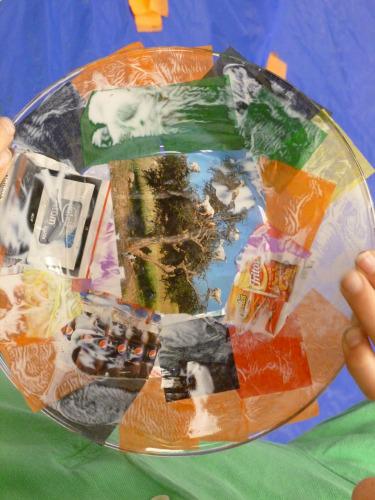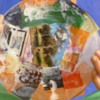Passover/The Last Supper
A Celebration ~ Passover Plate Art Workshop Lesson
Summary of Lesson Activities:
Decoupaging the back of a clear plastic plate, children will create a "celebration" (Seder, Passover) plate and discuss Passover and its tie to our celebration of Communion.
Scripture Reference:
Luke 22:7-23
Key Bible Verse:
Luke 22:19b “Do this in memory of me” (Good News Bible).
Rotation Objectives —
children will:
- Know that Jesus celebrated a special last meal (a Passover Seder) with his disciples before his crucifixion.
- Learn that at the Last Supper, Jesus gave new meaning to the bread and wine.
- Understand that the Christian observance of Holy Communion began with this “Last Supper”. We celebrate Communion today to remember Jesus’ death and resurrection.
- Discover that Communion is a way to feel closer to God and to other people who believe in God.
- Locate the story in their Bible, identifying the four Gospels (older students); Younger students will learn that the story is in the New Testament.
Materials List:
 Bibles (for 3rd grade and up)
Bibles (for 3rd grade and up)- Read with Me Bible (1st and 2nd grade)
- Clear Plastic Dinner Plates (one per student) inexpensively available in packs from suppliers and online
- Mod Podge "decoupage" glue
- Small cups (to distribute Mod Podge)
- Small paint brushes or foam brushes to apply Mod Podge to the plate and over the top of the paper.
- Magazines; Colorful tissue paper, printed Bible images from the internet
- Plastic table cloth
- Wet paper towels
- A fan to quicken drying of the plates
- Scissors
Before Start of Class:
- For younger students, you may want to copy and print some Bible images from the internet and cut them out ahead of time.
- Pour Mod Podge into small cups.
Lesson Plan
Opening:
Greet your students warmly, welcoming them to the Art Workshop. Introduce yourself and any other adults. Explain what they'll be doing and learning about today.
Bible Study:
For 3rd grade and up:
Ask: Where in the Bible would we read about Jesus and his disciples?
What are the first four books of the New Testament?
What do we call those first four books? (the Gospels)
Say: The word Gospel means “good news”. Jesus teaches us the good news about salvation offered by God.
Distribute Bibles. Have everyone find Luke 22:7-23 in his or her Bible.
Remind them about the quick way to find the New Testament. [Dividing the Bible in half gets them near Psalms in the OT. Dividing the back half in half again, gets them near beginning of the NT.]
Have students take turns reading verses 7-23. (In later weeks of the Rotation ask the students to tell you the story . Fill in any missing details.)
For 1st and 2nd graders:
Ask: If we want to read something that Jesus said, where would we find it – in the Old Testament or the New Testament of the Bible?
Say: We find the story of Jesus’ Last Supper with his disciples in the New Testament in the book of Luke.
Read pages 370-373 of The Read with Me Bible. Show pictures while reading. (In later weeks of the Rotation ask students to tell you the story. Fill in any missing details.)
Questions for all students:
Ask: When Jesus shared the Last Supper with his disciples, what Jewish holiday were they celebrating? (Passover) Why do Jewish people celebrate Passover?
Say: Jesus was celebrating Passover because he was Jewish. The first night of Passover is celebrated with a very special meal called a Seder.
Ask: Do you ever celebrate special meals with your family? What do you do to make the meal special? (Guide them to talk about using special dishes – i.e. plates.)
Making Your Own "Celebration" Passover Plate
Say: Today we are going to create a special celebration plate. You have already mentioned some special meals you share with your family and friends. Today you can make a plate that you take home and use at your next celebration dinner or during the upcoming Holy Week.
Describe how they will actually decoupage their plates:
- First, you will only be decoupaging the BACK OF THE PLATE. This allows the front eating surface of the plate to be used. It will also make the decoupaged paper look like glass.
- Think about a design. What do you want to "say" or depict on your plate with shapes, images, and color choices?
- Finding images and tearing tissue paper. They may decide to make the plate like "stained glass" using only thin sheets of tissue paper to create their design. Or they may find a special image(s) to place on their plate.
- Apply Mod Podge glue to the backside of the plate, then place the paper image or tissue over the glue and smoothing it INTO the glue.
- Work in sections, applying Mod Podge to the back of the plate when you're ready to apply the paper to that section.
Students' hand will begin to "get sticky." Provide wet paper towels.
Remind them to use LESS glue. INITIALLY, they only need to stick the paper to the back of the plate. They will "glue it all down" as the final step. Mod Podge is great at seeping in the cracks and through the tissue to create a hard surface. - When you're done applying the paper, brush one more coat of Mod Podge over the entire surface to create a hard finish.
- Lay the plate face-side-down to let the Mod Podge begin to dry. Have a fan blow air to quicken the drying.
Guide the students in thinking about decorating their plate. What will make a plate festive, or celebratory for them? What kind of images or design would remind them of Jesus' Last Supper, and way Jesus feeds our souls at his table?
Don't tell them "how" to make their plate look. Help them express their thoughts and feelings and understanding of the story in their own way.
Discussion: (while the kids are working)
Say: When Jesus celebrated the Last Supper with his disciples they were celebrating a Seder. Every part of a Seder reminds Jewish people of the story of the Exodus, how God saved his people from slavery in Egypt.
Ask: Are there any special foods we eat that remind us of something in particular? (Example: Thanksgiving – foods the Pilgrims ate; Easter – eggs remind us of new life)
Say: At the Last Supper Jesus gave new meaning to the bread and the cup. He took bread and a cup and said: “Do this in memory of me” (Good News Bible).
Ask: What do you suppose Jesus meant?
Why should we remember him?
Say: The Last Supper was the very last time Jesus ate with his disciples before he died. The disciples did not understand this, but Jesus knew what would happen. He knew that he would be killed on a cross and three days later would be alive again. Jesus knew he would be going to heaven and wouldn’t be around to be with his disciples. So Jesus wanted his disciples, and us, to always remember him.
Ask: Jesus said, “do this in remembrance of me.” How do we do that today?
Do the words I just read out of the Bible sound familiar? (are used in Communion service)
Ask: What things do we have in our Communion service, that were also in the Last Supper? (bread, “wine,” cup, table)
Say: When we celebrate Communion, we are following Jesus’ example from the Last Supper in the Bible. The words spoken in church during Communion are the same ones Jesus spoke to his disciples at the Last Supper. We remember what Jesus did to free us from slavery to sin. Jesus’ body, like the bread, was broken for us when he died on the cross. The cup was a symbol of Jesus’ blood shed for us.
Ask: Have you ever heard Communion described as the “sacrament of Communion”? What do you suppose that means?
Say: The word sacrament is related to the word “sacred” which means holy or set aside for the worship of God. When we celebrate Communion, we are setting aside the bread and juice as a special way to worship God.
Ask: If Communion is sacred or holy, what attitude should we have during Communion? (respectful, quiet)
Closing:
Have students share and describe their plate, what feelings about Jesus and our communion with him that they were trying to express.
Say: At the Last Supper Jesus gave new meaning to the bread and cup. They no longer are just reminders of what God did to save the Hebrews in Egypt, or even only about his "last" supper before the cross. Rather, they remind us what God did for the entire world when Jesus died on the cross, and that Jesus is still with us today, feeding and nourishing our spirits, comforting us and teaching us around his table.
Close with a prayer blessing our plates and the message they are intended to remind us of.
Take-Home Note:
Dear Families,
Today your child learned the story of Jesus’ Last Supper with his disciples. Ask your child what special holiday Jesus and his disciples were celebrating. (Hint: Passover – the celebration of the Israelites freedom from slavery in Egypt, as told in the Old Testament book of Exodus.)
To remember the Last Supper each artist created a Celebration Plate. Please use this dish in your family celebrations, noting these important care instructions: DO NOT IMMERSE in water. To clean, wipe the eating surface with a soapy cloth, rinse, and dry thoroughly. The eating surface is safe for food!
A lesson written by Carol Hulbert and improved by the Rotation.org Content Team




